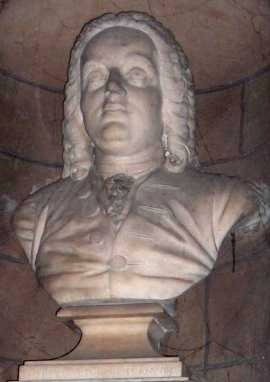The Lead Statue of the Duke of Cumberland d.1765),
by John Cheere.
1747.
Formerly on top of a Column at Emmet Square, Birr, (Parsons Town) County Offaly, Ireland.
Removed in 1915.
In 1747, Sir Laurence Parsons of Birr Castle who had inherited the estate in 1740,
commissioned a statue of the Butcher Cumberland and erected it on top of the handsome
Doric column that stood at the heart of his town.
The newly formed Birr
Freemason’s Lodge paraded in the towns’ equally new Palladian ‘Cumberland
Square’ to mark the occasion.
The Column was designed by Samuel Chearnley (1717 - 46).
Design by Chearnley in Armagh Public Library.
A letter
written by a William
Sturgeon to the
Bishop of Meath,
of 24 March
1743, quotes Chearnley as saying: "I have
always been a lover of architecture but this is
the first essay which Sir Laurence has put to
me". This makes explicit both Parsons’ patronage
of Chearnley, but also could be said to hint
at their collaborative relationship.
This letter
also contains Chearnley’s acknowledgement of Claude Perrault’s Ordnances des
Cinq Especes
des Colonnes,translated into English in 1708,
as the source for his design of his column in Birr.
The
statue itself was personally paid for by Parsons. It was executed by Cheere of
London, the same artist who executed the monument in memory of the Earl of
Cork, on the north side of the altar in Christ's Church, Dublin. Things did not
go wholly to plan. In a letter the Cheeres, expressed surprise when a crack
appeared in the Duke’s leg, but insisted that it could be mended by a plumber
and to pacify Sir Laurence, they included in the price a plaster bust of
Cumberland, polished to imitate marble which, they noted, was ‘exceeding like
and very handsome to stand in a room upon a table or chimney piece’
Dublin
Journal of 3 June 1746
"Sir
Laurence Parsons, Bart and other Gentlemen in the King’s County, from a
Principle of Loyalty,
are going at their own expense to raise a marble
pillar, fifty foot high, with a statue of the Duke
of Cumberland, on the top
of it, in honour of
his Royal Highness,
for defeating and vanquishing
the rebels at
Culleden-Muir"
Faulkner’s Dublin
Journal of 8
November 1746, as
follows:
"The Gentlemen
of the King’s
County assembled at
Parsonstown…and as they had before subscribed
a large sum for a pillar and statue of his
Royal Highness the Duke of Cumberland, they
thought no day more proper to lay the first stone of
the monument of their gratitude to this young
hero, who defended their civil and religious liberties"


Looking rather unsteady c.1915.

Sometime later!
The severed head of Cumberland now in Birr Castle.
The
head, which is owned by the Hunt
Museum, is currently on loan to the Earl of Rosse
and housed in Birr Castle, while part of the
arm is to be found the Birr public library. I will endeavour to obtain more photographs.
Much of the information here culled from the excellent and comprehensive Conservation report by Howley Hayes, Architects of Dublin, 2009-

Bust of Richard Parsons, First Earl of Rosse (1702 - 41). In St Patrick's Cathedral Dublin.
_______________________
Duke of Cumberland
Michael Rysbrack
Terracotta
signed on the back MICH:RYSBRACK 1754
Height 62 cms
Musee des Beaux Arts
Brussels
Bought from Spink of London 1936.
The Rysbrack busts were sold on behalf of Lord Hatherton, Stafford who was a Littleton and whose ancestor Sir Edward Littleton who had bought this and 7 other Rysbrack busts for Teddesly Hall, Stafford now demolished.
The Rysbrack Busts from Hatherton at the National Maritime Museum
___________________
Teddesley Hall,
Stafford





_______________________
Duke of Cumberland
Michael Rysbrack
Terracotta
signed on the back MICH:RYSBRACK 1754
Height 62 cms
Musee des Beaux Arts
Brussels
Bought from Spink of London 1936.
The Rysbrack busts were sold on behalf of Lord Hatherton, Stafford who was a Littleton and whose ancestor Sir Edward Littleton who had bought this and 7 other Rysbrack busts for Teddesly Hall, Stafford now demolished.
The Rysbrack Busts from Hatherton at the National Maritime Museum
"three now being in the NMM - made by Rysbrack for
Sir Edward Littleton, for Teddesley Hall, his new house near Stafford (now
demolished), which he was furnishing in the neo-classical style.
They
essentially comprised four pairs: Raleigh and Bacon (SCU0005), Shakespeare and
Pope, Cromwell (SCU0014) and Milton, and Newton and Locke. Lord Hatherton (the
Littleton barony dating from 1835) consigned these -excluding Shakespeare- and
other Rysbracks that his ancestor had purchased, with the related Rysbrack letters
about them, to Spink's for exhibition and sale in July 1932. Spink's related
illustrated catalogue by Mrs Arundell Esdaile ('The Art of John Michael
Rysbrack in Terracotta') fully transcribes the letters and is otherwise
comprehensive.
The Cromwell may date to as early as 1732, when Vertue saw one
of him in Rysbrack's workshop.
Previous Museum notes identify that of Pope as
possbly 1735 and in the National Portrait Gallery; Milton as 1738, now at
Stourhead (based on Rysbrack's Westminster Abbey monument and another bust done
for William Benson); Newton (1739), now at Trinity College, Cambridge; Locke
(1755?) in the Royal Collection.
That of Shakespeare is unlocated but the
V&A has one that may at least be a version. Raleigh and Bacon were
conceived as a pair and the most expensive at 25 guineas each, though the
sources for the Raleigh are not certain and it was not started until the Bacon
had been sent off in June 1757: the others were all 16 guineas.
These two, with
the Cromwell, were purchased for the Museum at Spink's by Sir James Caird.
In
1930 he had already bought from Hatherton, also through Spink, Hogarth's
portrait of Inigo Jones (BHC2810), which Sir Edward Littleton had commissioned
as another British notable".
Read more at http://collections.rmg.co.uk/collections/objects/63984.html#M8TgEs94KaH42z5B.99
Text above lifted from the National Maritime Museum
see - http://collections.rmg.co.uk/collections/objects/63984.html
___________________
Teddesley Hall,
Stafford







No comments:
Post a Comment